Batting 1.000 in the Hanseatic League
Northern Germany, September 6-9
Traveling north from Berlin, we encountered our first huge “hall church” in Prenzlau, a small city that has not yet recovered from Communism, World War II and, for that matter, the Thirty Years’ War. Usually built in the 14th Century, hall churches are distinguished by their enormous height and lack of transepts. We saw other, finer examples in Greifswald, Straslund and Lübeck, the other cities we visited in the Baltic region, but none was so striking as Prenzlau’s, which dwarfed all other buildings in town. Restoration work has begun, and Lutheran services are being held in a portion of the vast interior, which also contains an exhibit dedicated to the city’s former Jewish community.
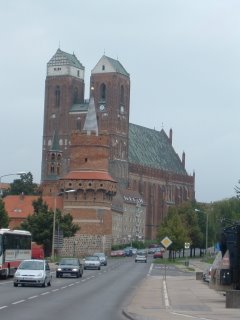
Prenzlau hall church

Greifswald
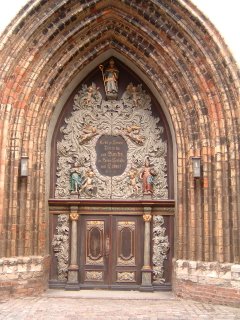
Nicholaikirche, Stralsund

21 C. door handle at Marienkirche, Lübeck
Long defunct, the Hanseatic League still provides architectural unity to its member cities, which copied each other’s achievements. It is hard to pick favorites, but we were taken by the 13th Century Heiliger-Geist-Hospital in Lübeck, where a few elderly persons still reside. Lübeck’s famous Holstentor should have been a winner, but like so many structures we wanted to photograph in the past six months, it was completely enshrouded in netting. At least this netting was embossed with a photograph of what lay beneath—in addition to the Deutsche Bank logo.
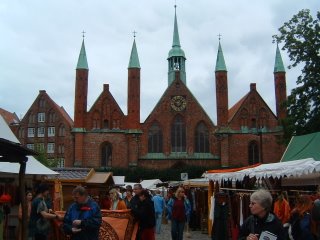
Heiliger-Geist-Hospital exterior and street fair
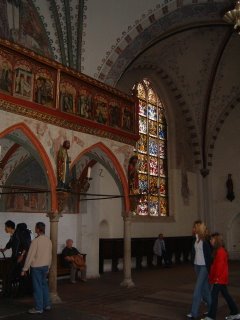
Heiliger-Geist-Hospital interior

Holstentor, Lübeck
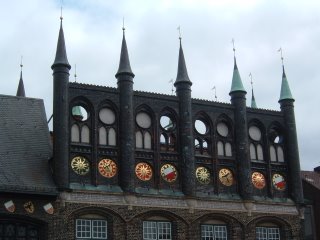
Lübeck Rathaus
The Hansa spirit carries over to community activities, such as the huge street fair that engulfed downtown Lübeck on Saturday with vendors in medieval dress. We sampled some traditional folk specialties at the fair but moved upscale for dinner at Wullenwever, a tremendously good restaurant (try their salad featuring paté de foie gras and figs) in a 16th Century townhouse. Lübeck’s patrician lifestyle was also in evidence earlier that day at the Buddenbrook-Haus, Thomas Mann’s childhood home, where we learned a great deal about Mann and his extraordinary family.
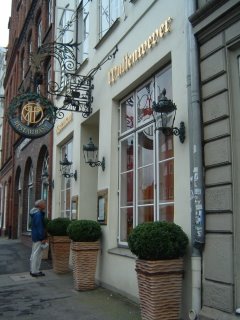
Checking the Wullenwever menu
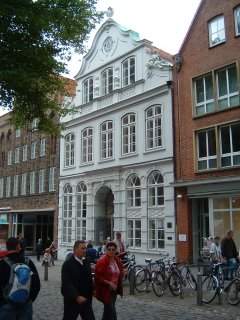
Thomas Mann's Buddenbrook house
Yes, sometimes you need to take a vacation from a vacation, and we did so for two nights on Rügen Island, which has been Germany’s premier seacoast resort since the early 20th Century. Rügen reminded us somewhat of Washington State’s San Juan Islands, which also combine agriculture and tourism. However, the beaches are white sand, many cliffs are white chalk, and there are many more vacationers. Their nationality was almost 100% German, but our excellent hotel, the Villa Granitz, took two Americans in stride.
Rügen is threaded with bicycle trails so we rented bikes to explore the island. Sad to say, we missed one trail sign and headed off on a dead-end road. By the time we recognized our mistake, the sky had darkened and rain began to fall as we headed for our hotel. Unfortunately, the trail we had chosen degenerated quickly into a cow pasture rut that quickly filled with rainwater. By the time we reached our hotel, we were soaked from the waist down (thank heavens for our Marmot parkas!). Dedicated bloggers would have sought out someone to photograph our appearance for posting, but we must admit to an occasional lack of dedication. Hence, the following Rügen scenes were recorded the following morning, when the sun was shining.

Beach at Baabe with "beach baskets," Rügen
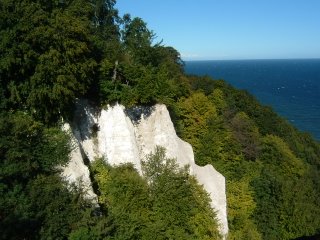
Chalk cliffs at Königsstuhl, Rügen

0 Comments:
Post a Comment
<< Home